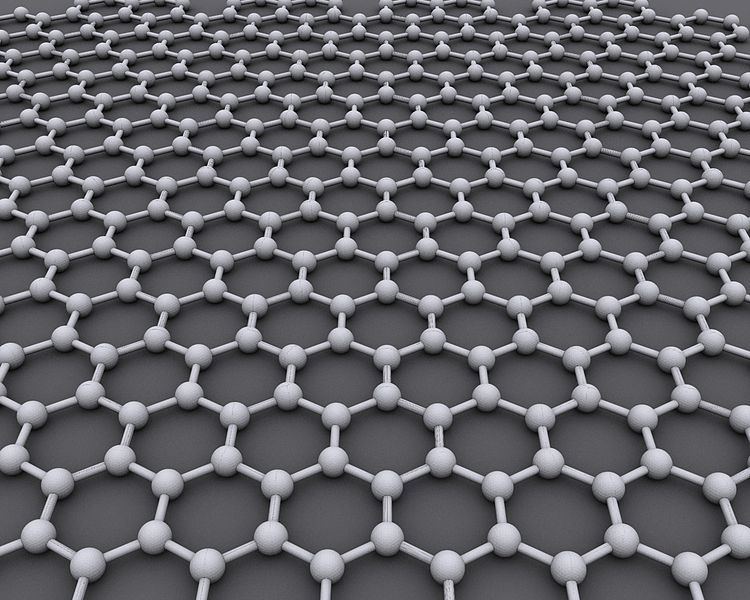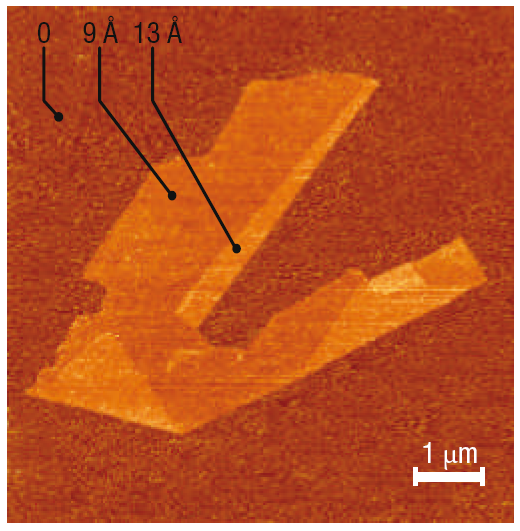Today it was announced that the 2010 Nobel prize in physics goes to Andre Geim and Konstantin Novoselov “for groundbreaking experiments regarding the two-dimensional material graphene.”
Geim’s and Novoselov’s work on graphene has been frequently predicted for the Nobel prize, although interestingly graphene has been studied long before they entered the field. Studies on graphene go back at least to the 1970s, and the name for this atomically thin layer of carbon came into more wider use in the 1980s.

A model of graphene. Image by AlexanderAlUS via Wikimedia Commons.
So what is the big deal with Geim’s and Novoselov’s research? Well, they developed a really simple method to fabricate graphene. Graphene is a close relative of graphite. Graphite consists of layers of carbon where in each layer the carbon atoms arrange as hexagons. These layers can be visualized as sheets of chicken wire.
Graphene is nothing but a single one of those sheets that make up graphite. The method Geim and Novoselov developed in 2004 to extract graphene is stunningly simple. Take a graphite pencil and write with it on a piece of paper. Then take a post-it note and use it to lift off tiny pieces of graphite. Look under the microscope and identify the single layer ones, and that’s it! But of course, in the meantime more efficient fabrication technologies for graphene have been developed.
As Geim, Novoselov, and many others consequently demonstrated, graphene is a unique material, fundamentally different to graphite. It is highly conducting, and electrons can travel through it for long distances without being deflected. This makes it interesting for fast transistors, and this is the point also of Geim and Novoselov’s ground-breaking first paper on graphene published in Science in 2004. Graphene shows also some interesting electronic properties owing to its electronic band structure, even the fractional quantum Hall effect.
And then of course the electronic bonds in graphene are very strong, which not unlike carbon nanotubes makes it an excellent structural material. Then there are possible applications in molecular sensing and many others. All this makes graphene highly interesting for researchers from many scientific areas. However, some of the rationale expressed by the Nobel Committee strikes me a bit odd, evidenced by this tweet: “According to Nobel Committee, practical applications for graphene include touch screens, fast transistors & DNA sequencing. #nobelprize.”

Flakes of graphene. Reprinted by permission from Macmillan Publishers Ltd. Nature Materials 6, 183-191 (2007).
Indeed, I agree that graphene has potential in all these areas. But we still have to see those promised applications. The last application in this list, DNA sequencing, is from a Nature paper less than a month old!
As for transistors, well, the edges of graphene cause a lot of problem, and so does fabrication. I recently blogged about attempts to use nanowires to make graphene transistors, which are still very far off commercial uses as well. And when it comes to the band structure properties of graphene such as the so-called Dirac point, well, topological insulators show similar physics but could be far more promising.
Graphene is a highly interesting and versatile material with cool properties. But when it comes to applications, well, we will see whether an all-rounder such as graphene will be able to beat incumbents. This is certainly far from clear yet. So please let’s stay realistic on the practical implications of graphene.
Overall of course, I am very happy for Geim and Novoselov, they certainly deserve the prize. At the same time I find it interesting that Sumio Iijima‘s discovery of carbon nanotubes hasn’t been rewarded yet.
In any case, it is a great week for UK science, with Nobel prizes in medicine and physics going to UK institutions. This recognition shows the high standard of UK science, which is presently in severe danger from government budget cuts.
Reference:
Novoselov, K., & Geim, A. (2004). Electric Field Effect in Atomically Thin Carbon Films Science, 306 (5696), 666-669 DOI: 10.1126/science.1102896
Further reading:
Geim, A., & Novoselov, K. (2007). The rise of graphene Nature Materials, 6 (3), 183-191 DOI: 10.1038/nmat1849
 This post was chosen as an Editor’s Selection for ResearchBlogging.org
This post was chosen as an Editor’s Selection for ResearchBlogging.org


October 6, 2010 at 17:08
My lecturer said today, its only a matter of time before this advancement is used by the US military to kill thousands of people. Graphene coated uranium bullets…or something like that.
October 6, 2010 at 17:48
well, graphene is an extremely tough material, particularly considering that it is just one layer of atoms thick. So I suppose the idea is to make really hard bullets. But I don’t know, I never heard of that application before. I suppose it can be possible, even though uranium bullets are pretty tough to begin with.
Applications in this area that seem more likely to me could be ones where carbon fibers or carbon nanotubes already play a role. Bullet proof vests, or other tough structural materials. It may seem mundane to merely pour sheets of graphene into mixtures with other materials such as polymers to make them tougher, but this could certainly be a realistic path to applications.
Generally, unfortunately there are always positive and negative consequences of doing science. As a society we all have to act responsibly with the scientific knowledge that we obtain…!
October 7, 2010 at 00:28
how about armor made of the same material?
October 7, 2010 at 10:00
Of course, that is a possibility, and some ceramic materials are indeed used for armor.
But generally, composites can enhance a material. For example, graphene (or carbon nanotubes) can stop cracks propagating through a material, which makes it tougher.
October 6, 2010 at 17:30
Wow, six years seems awfully little time to go from publishing your first paper to receiving a Nobel Prize. Makes me think the committee is basing this more on trendy enthusiasm and less on data. Not to say that their work isn’t worthwhile, but that their research seems to still be in its beginning stages.
October 6, 2010 at 17:49
Yes, six years is pretty short. Even Geim and Novoselov were surprised by the getting the Nobel that soon. Personally, I also would have preferred more of a wait to see some of the applications of graphene bear fruit. And as I argue, we might still be a long way away from that.
On the other hand, graphene shows some really interesting physics, properties for example that we know from particles close to the speed of light, so during the past few years graphene has been quite a playground for physicists. That’s why everybody pretty much expected for graphene to land the price at some stage. So overall I think it is quite ok to award the price now, even without major applications that made it to the market. Sometimes the wait between discovery and the Nobel can be far too long.
And as for speed, well, if you look at the discovery of high-temperature superconductors, these were discovered in 1986, and quite rightly got the price in 1987!
October 6, 2010 at 18:59
Please, the Nobel is like the Oscars, trend is all that ever matters. If Obama getting the peace prize didn’t tip you off to that then you have wisely ignored the Nobel as meaningless. Good job!
October 7, 2010 at 14:01
Never mind President Obama – how about Al Gore or worse, the late lamented head of the PLO?
There have been some cases even in the sciences where awards have been made, not because their scientific significance is all that great, but because they give excuses for promoting the philosophy of scientism (i.e., not allowing a Divine foot in the door).
October 7, 2010 at 14:11
Well, let’s focus on the sciences in this context. The peace prize is a very different thing.
And at least when it comes to the physics prize, I have to say that to me all physics topics so far that had a prize awarded were all significant and notable advances. Of course, there is always reason to debate who got the prize, and there are entire areas that are “overlooked”, but even Nobels are not an absolute statement of scientific greatness and in the end of the day always contain a subjective element…
October 6, 2010 at 17:57
Very interesting article 🙂 thx for the explanations
October 6, 2010 at 18:36
I was going to blog on the subject last night then passed. A brief check yesterday revealed to me( not a scientist)that a wait is in order before getting all jazzed up.
October 6, 2010 at 18:57
attractive article, thanks~
October 6, 2010 at 19:47
To get back to what Laura said in a previouse comment: Six years from publishing the first time to recieving the Nobel’s Prize. That’s insane – I think so too. Whether that’s an indication of how a prize is based on data or not, I can’t say. Maybe this was just one unique thinker?!
Best regards to all
October 6, 2010 at 20:37
Well, you guys might find this plot from The Economist of interest. It shows that generally it takes increasingly longer from discovery to winning a Nobel prize in physics:
http://www.economist.com/node/17194291
October 7, 2010 at 04:33
Very good article. I never underestimated the Noble prize. Thanks
October 7, 2010 at 04:37
Is there anyway we could run physical test on the graphene to get some accurate data on bond strength, elasticity, etc.?
October 7, 2010 at 10:14
The New York Times makes this comparison (http://www.nytimes.com/2010/10/06/science/06nobel.html):
“If scaled up to the thickness of plastic refrigerator wrap, a sheet of graphene stretched over a coffee cup could support the weight of a truck bearing down on a pencil point”
For a more scientific description from which this comparison is drawn, see this corresponding publication in Science:
http://dx.doi.org/10.1126/science.1157996
We’re talking of a Young’s modulus in the terapascal regime!!
October 8, 2010 at 07:20
Read about this in SciAm. Cool stuff.
November 2, 2010 at 17:32
Just a quick note to let you know that your post is included in the latest Scientia Pro Publica. Thank you for sharing it.